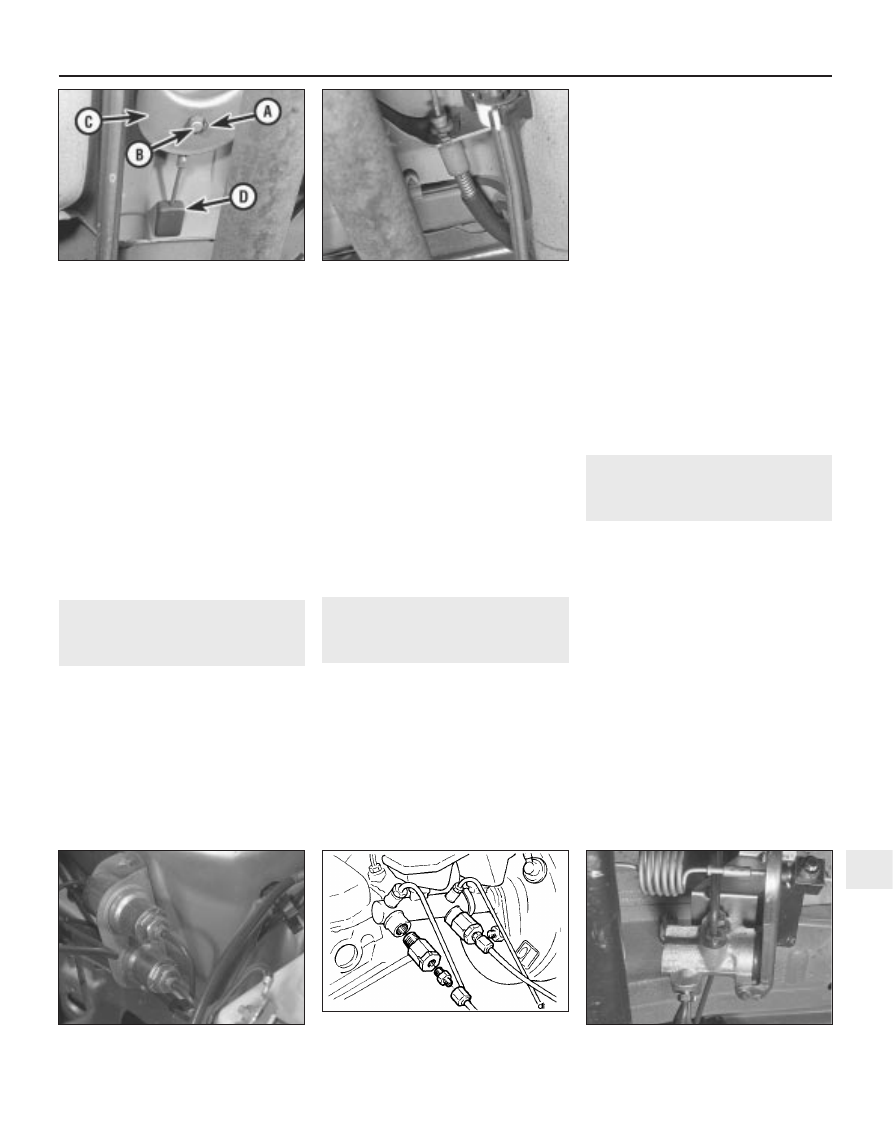Ford Fiesta (1989-1995). Instruction - part 45

the equaliser from the primary cable (see
illustration).
5 Remove the primary cable guide by drifting
it out rearwards, through the floorpan, from
the inside of the vehicle.
Refitting
6 Refit in the reverse order of removal. Ensure
that the cable guide is secured in the floorpan,
and lubricate the pivot pin with a liberal
amount of high-melting-point grease.
7 Refit the exhaust system and heat shields
with reference to Chapter 4E (where applicable).
8 Refer to Chapter 1 for details, and adjust
the handbrake as required before lowering the
vehicle to the ground.
19 Handbrake rear cable -
removal and refitting
2
Removal
1 Chock the front wheels then jack up the
rear of the car and support it on axle stands
(see “Jacking and Vehicle Support”). Fully
release the handbrake lever and remove the
rear roadwheels.
2 Refer to the previous Section for details,
and disconnect the handbrake primary cable
from the equaliser.
3 Disconnect the handbrake cable from its
adjuster body location and its fixed body
location (see illustration), then remove it from
its retaining clips.
4 Remove the rear brake drum(s) and brake
shoes as described in Sections 5 and 6
respectively.
5 Compress the handbrake cable retainer
lugs and release the cable from the backplate,
then pull the cable through. Release the cable
from the underbody fixings, and remove
it from the vehicle.
Refitting
6 Refitting is a reversal of the removal
procedure. Refer to Sections 6 and 5
respectively for details on the refitting of the
brake shoes and drums.
7 When the cable is fully refitted (but before
lowering the vehicle rear wheels to the
ground) check and adjust the handbrake as
described in Chapter 1.
20 Brake pressure control
valves - removal and refitting
3
Note: Before starting work, refer to the
warning at the beginning of Section 13
concerning the dangers of hydraulic fluid.
Removal
1 The pressure control valves are located in
the engine compartment, fixed to the left-
hand inner wing panel or screwed directly into
the master cylinder fluid outlet ports (see
illustrations).
2 Minimise hydraulic fluid loss by
disconnecting the wiring multi-plug from the
fluid level warning indicator in the master
cylinder reservoir filler cap, then remove the
filler cap. Note that the filler cap must not be
inverted. Place a piece of plastic film over the
reservoir and seal it with an elastic band.
Detach the rigid brake pipes from the valves.
As the pipes are disconnected, tape over the
exposed ends, or fit plugs, to prevent the
ingress of dirt and excessive fluid loss.
3 To remove the inner wing panel mounted
assembly, remove the two screws securing
the valve assembly mounting bracket to the
inner wing panel, and withdraw the valve
assembly from the vehicle. To remove the
valves from the bracket, slide free the
retaining clips and detach the valve(s).
4 To remove the master cylinder mounted
valves, unscrew them from the master
cylinder body.
Refitting
5 Refitting is a reversal of the removal
procedure.
6 On completion, bleed the complete
hydraulic system as described in Section 13.
21 Light-laden valve (Courier
models) - removal and
refitting
3
Note: Before starting work, refer to the
warning at the beginning of Section 13
concerning the dangers of hydraulic fluid.
Removal
1 For this operation, the vehicle must be
raised for access underneath at the rear, but
must still be resting on its wheels. Suitable
ramps (or an inspection pit) will therefore be
required. If positioning the vehicle on a pair of
ramps, chock the front roadwheels.
2 Minimise hydraulic fluid loss by
disconnecting the wiring multi-plug from the
fluid level warning indicator in the master
cylinder reservoir filler cap, then remove the
filler cap. Note that the filler cap must not be
inverted. Place a piece of plastic film over the
reservoir and seal it with an elastic band.
3 Disconnect the four brake pipes from the
valve, and drain any escaping fluid into a
suitable container for disposal (see
illustration). Due to its location, care will be
Braking system 9•13
19.3 Handbrake rear cable fixed body
location
18.4 Handbrake equaliser yoke
arrangement
A Clevis pin securing clip
B Clevis pin
C Equaliser yoke
D Primary cable guide
21.3 Hydraulic pipe and linkage
attachments at the light-laden valve
20.1b Pressure control valves and pipe
connections at the master cylinder - later
models
20.1a Pressure control valves located on
left-hand inner wing panel
9
1595Ford Fiesta Remake